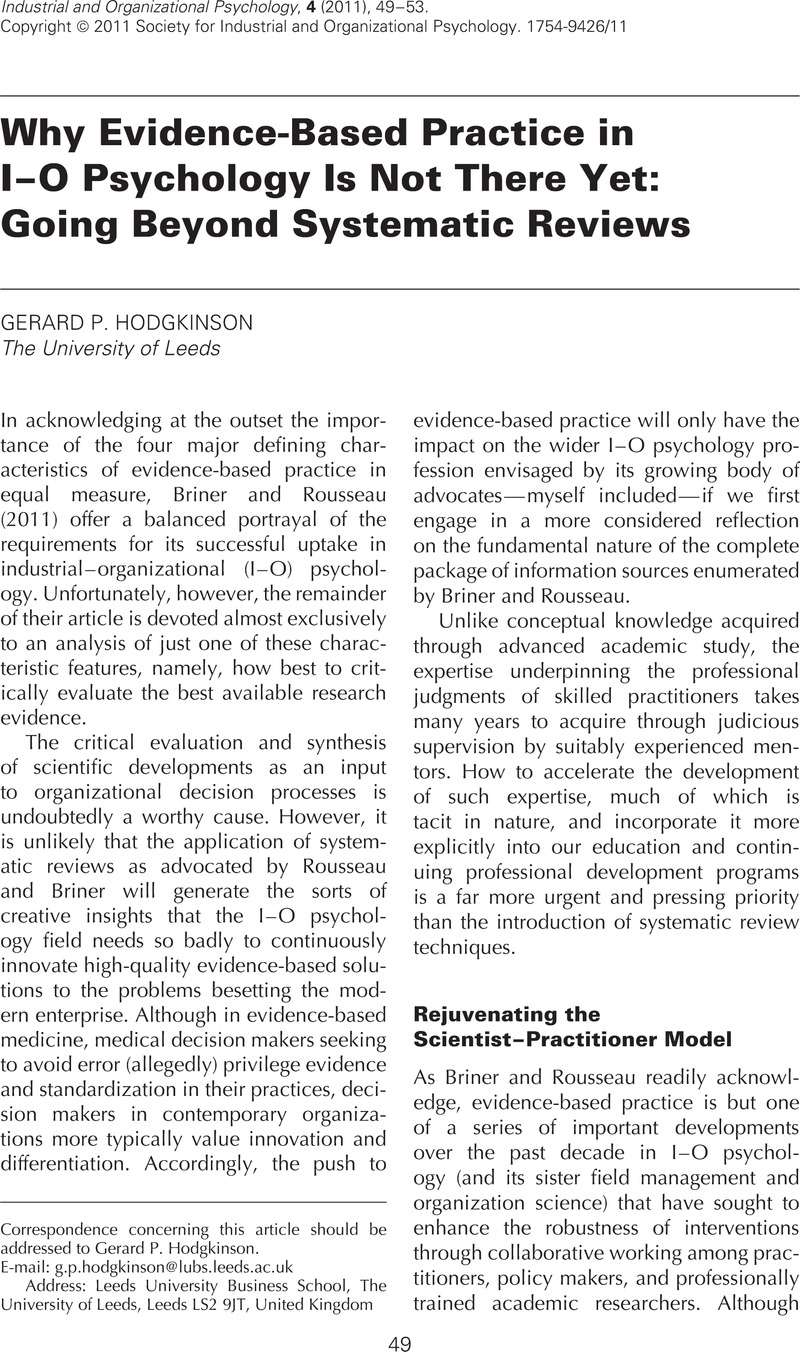Crossref Citations
This article has been cited by the following publications. This list is generated based on data provided by Crossref.
Briner, Rob B.
and
Rousseau, Denise M.
2011.
Evidence-Based I–O Psychology: Not There Yet but Now a Little Nearer?.
Industrial and Organizational Psychology,
Vol. 4,
Issue. 1,
p.
76.
Hodgkinson, Gerard P.
and
Starkey, Ken
2011.
Not Simply Returning to the Same Answer Over and Over Again: Reframing Relevance.
British Journal of Management,
Vol. 22,
Issue. 3,
p.
355.
Guest, David E.
and
Zijlstra, Fred R. H.
2012.
Academic perceptions of the research evidence base in work and organizational psychology: A European perspective.
Journal of Occupational and Organizational Psychology,
Vol. 85,
Issue. 4,
p.
542.
Hodgkinson, Gerard P.
and
Starkey, Ken
2012.
Extending the Foundations and Reach of Design Science: Further Reflections on the Role of Critical Realism.
British Journal of Management,
Vol. 23,
Issue. 4,
p.
605.
Hodgkinson, Gerard P.
2012.
The Oxford Handbook of Evidence-Based Management.
p.
404.
Kieser, Alfred
Nicolai, Alexander
and
Seidl, David
2015.
The Practical Relevance of Management Research: Turning the Debate on Relevance into a Rigorous Scientific Research Program.
The Academy of Management Annals,
Vol. 9,
Issue. 1,
p.
143.
Kieser, Alfred
Nicolai, Alexander
and
Seidl, David
2015.
The Practical Relevance of Management Research: Turning the Debate on Relevance into a Rigorous Scientific Research Program.
Academy of Management Annals,
Vol. 9,
Issue. 1,
p.
143.
Bartlett, Dean
and
Francis-Smythe, Jan
2016.
Bridging the divide in work and organizational psychology: evidence from practice.
European Journal of Work and Organizational Psychology,
Vol. 25,
Issue. 5,
p.
615.
Caetano, António
and
Santos, Susana C.
2017.
Organizational Psychology and Evidence-Based Management.
p.
1.
Nokes, Karen
and
Hodgkinson, Gerard P.
2017.
Methodological Challenges and Advances in Managerial and Organizational Cognition.
Vol. 2,
Issue. ,
p.
95.
Rynes, Sara L.
and
Bartunek, Jean M.
2017.
Evidence-Based Management: Foundations, Development, Controversies and Future.
Annual Review of Organizational Psychology and Organizational Behavior,
Vol. 4,
Issue. 1,
p.
235.
YAVUZ, Meltem
2020.
Towards A Better Cost and Quality Structure Through Organisational Development Interventions: A Case Study.
The Journal of Social Science,
Hodgkinson, Gerard P.
2021.
Why appealing to the virtues of scientific theory (and method) is necessary but insufficient for effecting systemic change: Commentary on Fergnani & Chermack, 2021.
FUTURES & FORESIGHT SCIENCE,
Vol. 3,
Issue. 3-4,
Arnold, John
Dries, Nicky
and
Gabriel, Yiannis
2021.
EJWOP Special Issue: Enhancing the Social Impact of Research in Work and Organizational Psychology – Beyond Academia.
European Journal of Work and Organizational Psychology,
Vol. 30,
Issue. 3,
p.
329.





